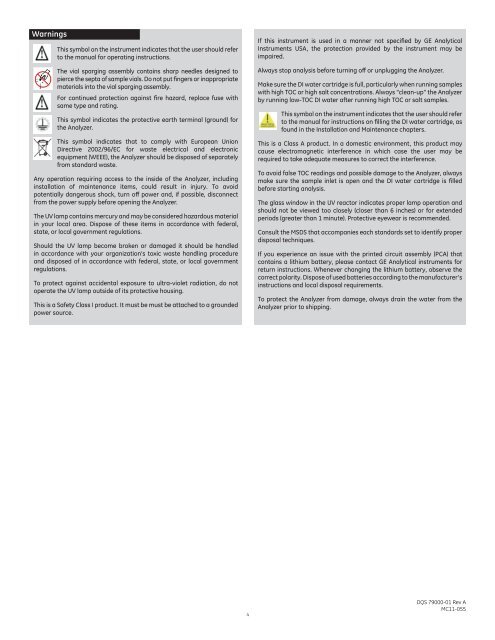Sievers 860 Laboratory TOC Analyzer - GE Analytical Instruments
Sievers 860 Laboratory TOC Analyzer - GE Analytical Instruments Sievers 860 Laboratory TOC Analyzer - GE Analytical Instruments
WarningsThis symbol on the instrument indicates that the user should referto the manual for operating instructions.The vial sparging assembly contains sharp needles designed topierce the septa of sample vials. Do not put fingers or inappropriatematerials into the vial sparging assembly.For continued protection against fire hazard, replace fuse withsame type and rating.This symbol indicates the protective earth terminal (ground) forthe Analyzer.This symbol indicates that to comply with European UnionDirective 2002/96/EC for waste electrical and electronicequipment (WEEE), the Analyzer should be disposed of separatelyfrom standard waste.Any operation requiring access to the inside of the Analyzer, includinginstallation of maintenance items, could result in injury. To avoidpotentially dangerous shock, turn off power and, if possible, disconnectfrom the power supply before opening the Analyzer.The UV lamp contains mercury and may be considered hazardous materialin your local area. Dispose of these items in accordance with federal,state, or local government regulations.Should the UV lamp become broken or damaged it should be handledin accordance with your organization’s toxic waste handling procedureand disposed of in accordance with federal, state, or local governmentregulations.To protect against accidental exposure to ultra-violet radiation, do notoperate the UV lamp outside of its protective housing.This is a Safety Class I product. It must be must be attached to a groundedpower source.If this instrument is used in a manner not specified by GE AnalyticalInstruments USA, the protection provided by the instrument may beimpaired.Always stop analysis before turning off or unplugging the Analyzer.Make sure the DI water cartridge is full, particularly when running sampleswith high TOC or high salt concentrations. Always “clean-up” the Analyzerby running low-TOC DI water after running high TOC or salt samples.This symbol on the instrument indicates that the user should referto the manual for instructions on filling the DI water cartridge, asfound in the Installation and Maintenance chapters.This is a Class A product. In a domestic environment, this product maycause electromagnetic interference in which case the user may berequired to take adequate measures to correct the interference.To avoid false TOC readings and possible damage to the Analyzer, alwaysmake sure the sample inlet is open and the DI water cartridge is filledbefore starting analysis.The glass window in the UV reactor indicates proper lamp operation andshould not be viewed too closely (closer than 6 inches) or for extendedperiods (greater than 1 minute). Protective eyewear is recommended.Consult the MSDS that accompanies each standards set to identify properdisposal techniques.If you experience an issue with the printed circuit assembly (PCA) thatcontains a lithium battery, please contact GE Analytical instruments forreturn instructions. Whenever changing the lithium battery, observe thecorrect polarity. Dispose of used batteries according to the manufacturer’sinstructions and local disposal requirements.To protect the Analyzer from damage, always drain the water from theAnalyzer prior to shipping.4DQS 79000-01 Rev AMC11-055
- Page 6 and 7: 步 骤 5 连 接 出 口废 液
- Page 8: 警 告仪 器 上 标 有 此 符
WarningsThis symbol on the instrument indicates that the user should referto the manual for operating instructions.The vial sparging assembly contains sharp needles designed topierce the septa of sample vials. Do not put fingers or inappropriatematerials into the vial sparging assembly.For continued protection against fire hazard, replace fuse withsame type and rating.This symbol indicates the protective earth terminal (ground) forthe <strong>Analyzer</strong>.This symbol indicates that to comply with European UnionDirective 2002/96/EC for waste electrical and electronicequipment (WEEE), the <strong>Analyzer</strong> should be disposed of separatelyfrom standard waste.Any operation requiring access to the inside of the <strong>Analyzer</strong>, includinginstallation of maintenance items, could result in injury. To avoidpotentially dangerous shock, turn off power and, if possible, disconnectfrom the power supply before opening the <strong>Analyzer</strong>.The UV lamp contains mercury and may be considered hazardous materialin your local area. Dispose of these items in accordance with federal,state, or local government regulations.Should the UV lamp become broken or damaged it should be handledin accordance with your organization’s toxic waste handling procedureand disposed of in accordance with federal, state, or local governmentregulations.To protect against accidental exposure to ultra-violet radiation, do notoperate the UV lamp outside of its protective housing.This is a Safety Class I product. It must be must be attached to a groundedpower source.If this instrument is used in a manner not specified by <strong>GE</strong> <strong>Analytical</strong><strong>Instruments</strong> USA, the protection provided by the instrument may beimpaired.Always stop analysis before turning off or unplugging the <strong>Analyzer</strong>.Make sure the DI water cartridge is full, particularly when running sampleswith high <strong>TOC</strong> or high salt concentrations. Always “clean-up” the <strong>Analyzer</strong>by running low-<strong>TOC</strong> DI water after running high <strong>TOC</strong> or salt samples.This symbol on the instrument indicates that the user should referto the manual for instructions on filling the DI water cartridge, asfound in the Installation and Maintenance chapters.This is a Class A product. In a domestic environment, this product maycause electromagnetic interference in which case the user may berequired to take adequate measures to correct the interference.To avoid false <strong>TOC</strong> readings and possible damage to the <strong>Analyzer</strong>, alwaysmake sure the sample inlet is open and the DI water cartridge is filledbefore starting analysis.The glass window in the UV reactor indicates proper lamp operation andshould not be viewed too closely (closer than 6 inches) or for extendedperiods (greater than 1 minute). Protective eyewear is recommended.Consult the MSDS that accompanies each standards set to identify properdisposal techniques.If you experience an issue with the printed circuit assembly (PCA) thatcontains a lithium battery, please contact <strong>GE</strong> <strong>Analytical</strong> instruments forreturn instructions. Whenever changing the lithium battery, observe thecorrect polarity. Dispose of used batteries according to the manufacturer’sinstructions and local disposal requirements.To protect the <strong>Analyzer</strong> from damage, always drain the water from the<strong>Analyzer</strong> prior to shipping.4DQS 79000-01 Rev AMC11-055



